that pipe is a straight shot through the dam? so any erosion it causes is eroding the dam correct? If so you're going to need a tailrace to keep the dam from being damaged by the outflow for sure
Perhaps either extend the pipe down the backside of the dam to the ditch below, or build a thick concrete tailrace for the water to flow on down the backside. Otherwise you will be battling erosion forever.
Thanks for the replies.... yes, it is a straight shot they the dam. I thought about extending the pipe down the dam wall, but do they make a 15Ē flexible corrugated pipe? Or would I just do like a 45 degree coupling to turn it down and straight sections from there? The tailrace sounds like a good idea as well. Also, would I need to put anything around the pipe at the entrance into the dam on the pond side? To keep it from possibly washing out around it from maybe suction? Thanks!!
Is this the only outlet? I don't see an emergency spillway.
I can tell you what I did on one of my pond and it seemed to work. It has a 12" PVC pipe and it angles down dramatically which increases velocity and capacity during flooding. I dug a pit below the outlet side of the pipe and placed a 6" drain to another downstream pond. I capped up-end of the smaller drain with a wire trash rack and filled the hole with rip rap. During heavy flow the structure spreads out the water flowing over the grass (that the 6" drain will not handle). During the rest of the time, the small drain gives the above-ground area time to grow tall grass. Tall grass lays down during flooding protecting the soil beneath. I used the same strategy on my newly finished pond (but on a smaller scale), but it has not yet been tested. I have emergency spillways on all 3 of my "fish" ponds and wish that I had them on 2 constructed wetland that do not. They were constructed by contractors and have a very level berm which has so far handled overflow. Good luck!
This is the only outlet...
That sounds like it would work, but for me to place something like that below the outlet I would be digging right into the dam itself, not sure I would want to do that. I am thinking I will look at placing more large stones where it has eroded and then using concrete between any of the gaps of the rocks and build it up on the sides to essentially make a tailrace.
Hmmmm... I didn't know they made 22.5 degree elbows.. that I think will work. Thx!
Post some pictures of the project for us to see and let us know how it works out.
Post some pictures of the project for us to see and let us know how it works out.
Will do...
Just curious...If this outlet is extended with more corrugated pipe, could you place a T or two inline to serve as clear outs?? Would capping the T help prevent the vacuum created?
Just curious...If this outlet is extended with more corrugated pipe, could you place a T or two inline to serve as clear outs?? Would capping the T help prevent the vacuum created?
Well, if they make a Y then that may be better than T as a clear out...or less abrupt direction change. Even with just adding a 22 degree bend and more pipe I'm a little concerned about restricting the flow.
Once the pipe is full and not pulling air from the inlet (given enough head on the dam and installation of an anti-vortex device), the increased drop after adding the pipe will probably increase flow considerably rather than decreasing it. That assumes you do not install a T or Y (or any other way for air to get in). That is why my pond pipes all slope down as much as possible leaving the pond. Think about it like starting a siphon and what happens to the flow rate as you drop the outlet side of the tube. The weight of the water dropping actually pulls water into the pipe. Its like having a bigger pipe without the added cost.
Without an emergency spillway you will have to be extra vigilant about making sure your pipe remains debris-free. If your dam gets over-topped you can lose the whole thing in a hurry. A debris guard can help a lot.
I wonder if that thin wall plastic pipe can withstand the forces of a full siphon effect if you extend the pipe down the back of the dam. You may not want to install an anti-vortex plate unless the manufacturer can verify it won't collapse.
I wonder if that thin wall plastic pipe can withstand the forces of a full siphon effect if you extend the pipe down the back of the dam. You may not want to install an anti-vortex plate unless the manufacturer can verify it won't collapse.
That's a good point... I am still leaning toward just using existing large stone stacked wider and then fill all of the gaps with fast setting quickrete to smooth it out into a tialrace. With the sides maybe 6-8" higher than the middle.
Hello Neo, welcome to the forum. Myself and others wish that we would have found this forum before building our ponds, as I wish that you would have found this forum before constructing your pond.
Hate to be a downer and I hope that I am wrong, but from looking at the pics I suspect itís just a matter of time before the runoff from a heavy rain event completely overwhelms that shallow buried 15Ē drain pipe. The resulting flow of water over the dam could completely unearth the pipe as it carves a deep trench thru the dam, draining the pond
Normally, the top of the primary drain pipe should be about 1ft below the level of the emergency spillway. ( the spillway is a wide flat path going around the end of the dam, over undisturbed soil, often covered with grass, rip rap, or concrete) The elevation of the emergency spillway should be 2 or more feet lower than the top of the dam. The difference in elevation from the top of dam to the spillway is known as the free board. (from the pictures it appears you only have less than 1ft of freeboard above the primary drain)
When determining the size of the primary and secondary drains it is important to calculate the area of watershed which funnels into the pond. From the pictures it appears to me that your pond could receive a massive influx of water during a heavy rain event. (then again, I donít know the total size of the watershed, or how much of the runoff may be diverted around the pond)
Personally, I would either lower the primary drain, or increase the height of the dam, thereby increasing the free board. And I would definitely use a tractor or other equipment to carve an emergency spillway around the dam.
If you do add to the existing drain pipe down the backside of the dam you should probably dig a trench and bury the pipe, as a way of anchoring it. A 15Ē lightweight pipe pulling a siphon needs to be securely anchored.
Oh yeah, I forgot to mention that your pond is actually pretty cool looking, and I hope you're successful with it.
Hello Neo, welcome to the forum. Myself and others wish that we would have found this forum before building our ponds, as I wish that you would have found this forum before constructing your pond.
Hate to be a downer and I hope that I am wrong, but from looking at the pics I suspect itís just a matter of time before the runoff from a heavy rain event completely overwhelms that shallow buried 15Ē drain pipe. The resulting flow of water over the dam could completely unearth the pipe as it carves a deep trench thru the dam, draining the pond
Normally, the top of the primary drain pipe should be about 1ft below the level of the emergency spillway. ( the spillway is a wide flat path going around the end of the dam, over undisturbed soil, often covered with grass, rip rap, or concrete) The elevation of the emergency spillway should be 2 or more feet lower than the top of the dam. The difference in elevation from the top of dam to the spillway is known as the free board. (from the pictures it appears you only have less than 1ft of freeboard above the primary drain)
When determining the size of the primary and secondary drains it is important to calculate the area of watershed which funnels into the pond. From the pictures it appears to me that your pond could receive a massive influx of water during a heavy rain event. (then again, I donít know the total size of the watershed, or how much of the runoff may be diverted around the pond)
Personally, I would either lower the primary drain, or increase the height of the dam, thereby increasing the free board. And I would definitely use a tractor or other equipment to carve an emergency spillway around the dam.
If you do add to the existing drain pipe down the backside of the dam you should probably dig a trench and bury the pipe, as a way of anchoring it. A 15Ē lightweight pipe pulling a siphon needs to be securely anchored.
Oh yeah, I forgot to mention that your pond is actually pretty cool looking, and I hope you're successful with it.
Thank you gully washer.... Well the concern about the drain being so high was also a concern of mine when I spoke with the creator of the pond, but he told me it would be fine... I suppose building up the dam would be the easiest and less costly fix for increasing the free board. I have a tractor that I could use and plenty of places on the property to get the dirt.
On the emergency spillway, I am not sure clear on what you are saying, but I assume it is a spot in the dam that is higher than the exit pipe and around 2 ft less than the top of the dam.... I could possibly do that on the far right side of the dam, as it was natural hillside and not man made. So I guess if I built the dam up all the way across except for a few feet on the right side of the exit pipe that could work..?
The inflow of water is from a small stream, actually just ravines that direct are naturally directed down toward the pond from the hills behind it. Normally it is fairly dry to non-existent, but I have seen it flow fairly good if we have had a lot of rain.
I appreciate the input...and the way you presented it. I have attached a few more epics to show it during the building phase...
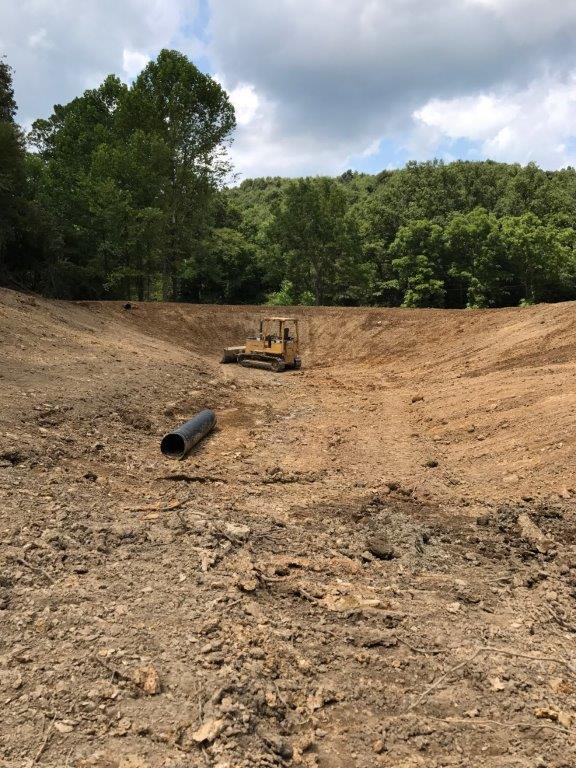

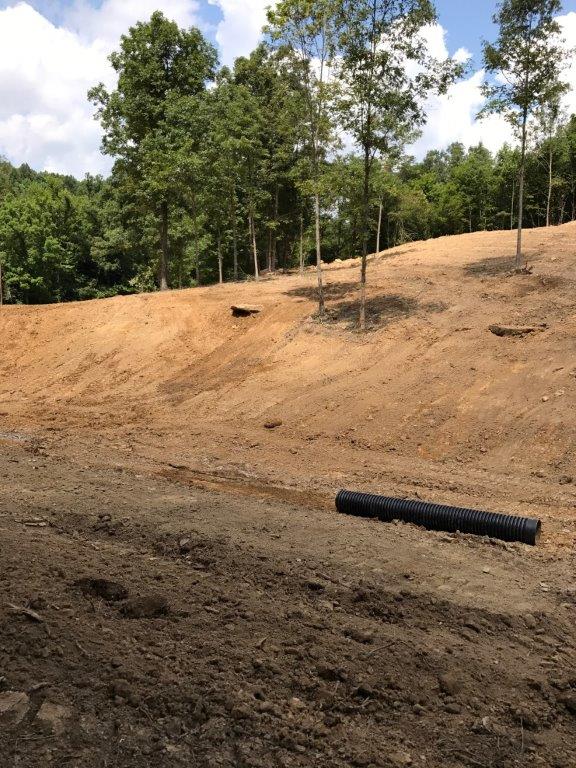

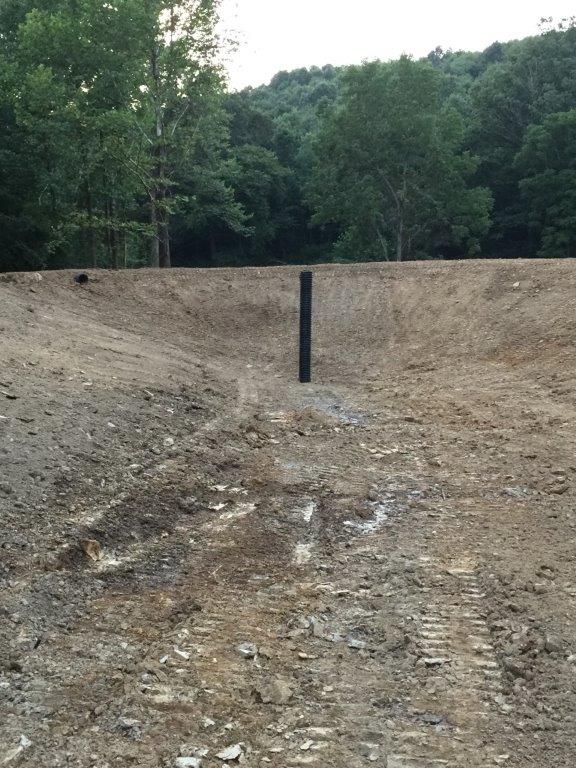
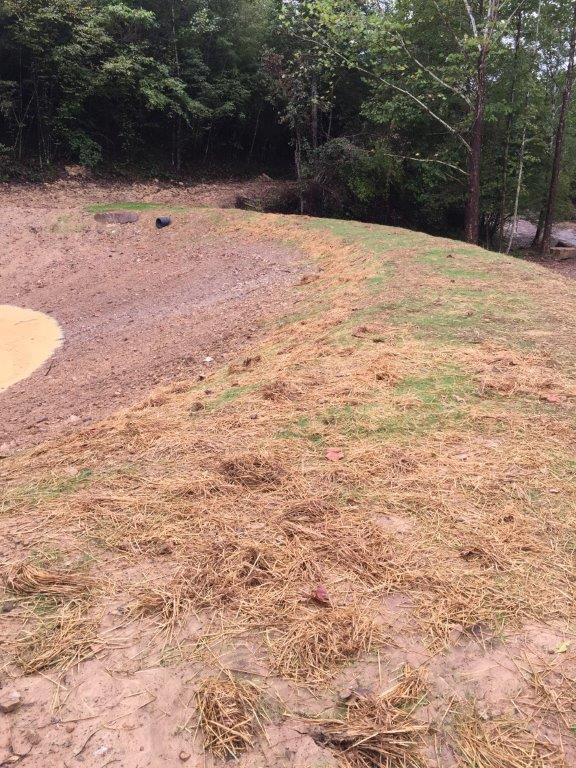
Welcome to the PB Forum
Agree with Gully, all it takes to block the water flow is a couple of sticks and if enough water coming in it's over....... not good! Looks nice though. Look into spillway options as well
Welcome to the PB Forum
Agree with Gully, all it takes to block the water flow is a couple of sticks and if enough water coming in it's over....... not good! Looks nice though. Look into spillway options as well
Thanks Pat... will do.
An E-spillway is a must, and you got the idea right....the level of the E-spillway should be about 6"- to a foot above the top of your primary drain, slope AWAY from the dam slowly, and be at least 15 feet wide and well vegetated to prevent erosion/washout if used.
As for your drain pipe.....2 ways to fix it...pull out the rip-rap, re-grade and compact the eroded soil in a curved shape to channel the water, then put down heavy plastic or geotextile fabric and re-lay the rip-rap....this will eventually fail again years later.......best way is to pour a quality, concrete tail race, also in a channeled shape with rip rap on the edges to help keep water on the concrete.
As for the pond side of your pond, check out PondDamPiping.com and get the correct sze trash rack to prevent blockages
if money isn't an issue, i would install a siphon system. i am a fan of a traditional standpipe, but it is way too late for that now.
did you all calculate your water shed? sure looks like you have a lot of hills that are going to dump water in your pond during a rain.
and like said above, an emergency spillway is a must.
Getting the dam higher such that water will run around it, not over it, during flooding would be my priority (feet of free-board above gently sloping emergency spillway in virgin soil). Just dumping more dirt on top is unlikely to work well. Any topsoil on the top of the dam really needs to be removed, and the core of the dam raised in elevation in compacted layers. I know this is not what you want to hear, but if you can swing the cost now, it will likely save you money in the long run. It would also be money well spent to lower your water level and install the drain pipe properly now. On my second pond, I went through 2 contractors before hiring folks to fix problems which included replacing a poorly installed drain pipe and raising the dam height. In my case, I did this before the pond filled and I have a worry-free pond. I had not budgeted for this, but things don't always go as planned, and there are a lot of dirt pushers out there. Finding a pond builder is a lot harder. I built my 3rd pond myself but it has yet to be tested, so I cannot claim success yet.
An E-spillway is a must, and you got the idea right....the level of the E-spillway should be about 6"- to a foot above the top of your primary drain, slope AWAY from the dam slowly, and be at least 15 feet wide and well vegetated to prevent erosion/washout if used.
As for your drain pipe.....2 ways to fix it...pull out the rip-rap, re-grade and compact the eroded soil in a curved shape to channel the water, then put down heavy plastic or geotextile fabric and re-lay the rip-rap....this will eventually fail again years later.......best way is to pour a quality, concrete tail race, also in a channeled shape with rip rap on the edges to help keep water on the concrete.
As for the pond side of your pond, check out PondDamPiping.com and get the correct sze trash rack to prevent blockages
Thank you Rainman, sounds like some good advice... I believe that is what I am going to work on. I am going to have to sump the water level down first so I can get that done.
Getting the dam higher such that water will run around it, not over it, during flooding would be my priority (feet of free-board above gently sloping emergency spillway in virgin soil). Just dumping more dirt on top is unlikely to work well. Any topsoil on the top of the dam really needs to be removed, and the core of the dam raised in elevation in compacted layers. I know this is not what you want to hear, but if you can swing the cost now, it will likely save you money in the long run. It would also be money well spent to lower your water level and install the drain pipe properly now. On my second pond, I went through 2 contractors before hiring folks to fix problems which included replacing a poorly installed drain pipe and raising the dam height. In my case, I did this before the pond filled and I have a worry-free pond. I had not budgeted for this, but things don't always go as planned, and there are a lot of dirt pushers out there. Finding a pond builder is a lot harder. I built my 3rd pond myself but it has yet to be tested, so I cannot claim success yet.
I think I can do the emergency spillway to the right of the drain. It actually has an old logging road that follows the natural path of the hillside and I could then slope it gently down the hill into the creek where the current overflow is now going. Thanks.
Be sure to cut the bottom of the emergency spillway a foot or more higher than the top of the primary pipe elevation so it will not take water until the primary pipe cannot handle it. A simple homemade anti-vortex device will also maximize the flow through the pipe.
Be sure to cut the bottom of the emergency spillway a foot or more higher than the top of the primary pipe elevation so it will not take water until the primary pipe cannot handle it. A simple homemade anti-vortex device will also maximize the flow through the pipe.
Gotcha, thx!
Neo07, you've gotten lots of good advice.
If you're worried about the immediate damage to the back of the dam, then I might look at geotextile road fabrics. I've been using it for several years now under limestone rocks on 24' watershed pipes, and a small emergency spillway. Erosion has pretty much stopped.
Neo07, you've gotten lots of good advice.
If you're worried about the immediate damage to the back of the dam, then I might look at geotextile road fabrics. I've been using it for several years now under limestone rocks on 24' watershed pipes, and a small emergency spillway. Erosion has pretty much stopped.
I agree.
Ok, thanks, I will.
On the emergency spillway, I am not sure clear on what you are saying, but I assume it is a spot in the dam that is higher than the exit pipe and around 2 ft less than the top of the dam.... I could possibly do that on the far right side of the dam, as it was natural hillside and not man made. So I guess if I built the dam up all the way across except for a few feet on the right side of the exit pipe that could work..?
Yes, thatís the right ideaÖ.........Ö. You might consult with your dirt guy about raising the dam 3' or 4'. A dozer can get it done in a few days, whereas using a tractor could take weeks.(depending on number of hours per day spent in the tractor seat) Maybe the dirt guy will feel guilty for not doing a proper build, and cut you a deal. From the pics, it certainly looks like he knows how to work dirt, and he should understand the need for some free board, and a spillway.
On the emergency spillway, I am not sure clear on what you are saying, but I assume it is a spot in the dam that is higher than the exit pipe and around 2 ft less than the top of the dam.... I could possibly do that on the far right side of the dam, as it was natural hillside and not man made. So I guess if I built the dam up all the way across except for a few feet on the right side of the exit pipe that could work..?
Yes, thatís the right ideaÖ.........Ö. You might consult with your dirt guy about raising the dam 3' or 4'. A dozer can get it done in a few days, whereas using a tractor could take weeks.(depending on number of hours per day spent in the tractor seat) Maybe the dirt guy will feel guilty for not doing a proper build, and cut you a deal. From the pics, it certainly looks like he knows how to work dirt, and he should understand the need for some free board, and a spillway.
Ok, sounds good... well actually, the guy doing the dozer work was a friend of my sons... he had built a few ponds but had only been using a dozer for about a year. I have less than 1500.00 in the whole thing. Of course now it looks like I'm going to have to make a couple of mods, but all in all I am pleased with it. Thx.
Hello Neo, welcome to the forum. Myself and others wish that we would have found this forum before building our ponds, as I wish that you would have found this forum before constructing your pond.
Hate to be a downer and I hope that I am wrong, but from looking at the pics I suspect itís just a matter of time before the runoff from a heavy rain event completely overwhelms that shallow buried 15Ē drain pipe. The resulting flow of water over the dam could completely unearth the pipe as it carves a deep trench thru the dam, draining the pond
Normally, the top of the primary drain pipe should be about 1ft below the level of the emergency spillway. ( the spillway is a wide flat path going around the end of the dam, over undisturbed soil, often covered with grass, rip rap, or concrete) The elevation of the emergency spillway should be 2 or more feet lower than the top of the dam. The difference in elevation from the top of dam to the spillway is known as the free board. (from the pictures it appears you only have less than 1ft of freeboard above the primary drain)
When determining the size of the primary and secondary drains it is important to calculate the area of watershed which funnels into the pond. From the pictures it appears to me that your pond could receive a massive influx of water during a heavy rain event. (then again, I donít know the total size of the watershed, or how much of the runoff may be diverted around the pond)
Personally, I would either lower the primary drain, or increase the height of the dam, thereby increasing the free board. And I would definitely use a tractor or other equipment to carve an emergency spillway around the dam.
If you do add to the existing drain pipe down the backside of the dam you should probably dig a trench and bury the pipe, as a way of anchoring it. A 15Ē lightweight pipe pulling a siphon needs to be securely anchored.
Oh yeah, I forgot to mention that your pond is actually pretty cool looking, and I hope you're successful with it.
Ok.... well the predicted did happen... so now, I am planning on digging an emergency spillway in the area indicated on the pics... I believe this is an old logging road cut into the hillside probably 15-20 years ago so it should be solid. I was planning on just digging it out with my Kioti backhoe and FEL. I know I donít have much freeboard and Iím planning on building the dam up some over the current pipe with the excess dirt I take out for the spillway. Although some of the dirt will also be used to fix the dam on the overflow side where it is washed out. I would like some ideas as to if this is the best way to do it without spending a fortune. I am going to create a concrete and rock tailrace under the overflow pipe as well to keep it from eating away the dam on the overflow side.
The way I see it right now I have possibly 3 options, as listed below:
1) Dig out an emergency spillway on the area marked in the pic. It is probably about 75' to the ravine from the pond that I would need to dig out.
2) Remove the existing 18" overflow and create a concrete spillway wider that goes over the dam where the pipe was and forget the emergency spillway.
3) Remove the 18" overflow pipe and replace it with a larger 24" - 30" pipe.

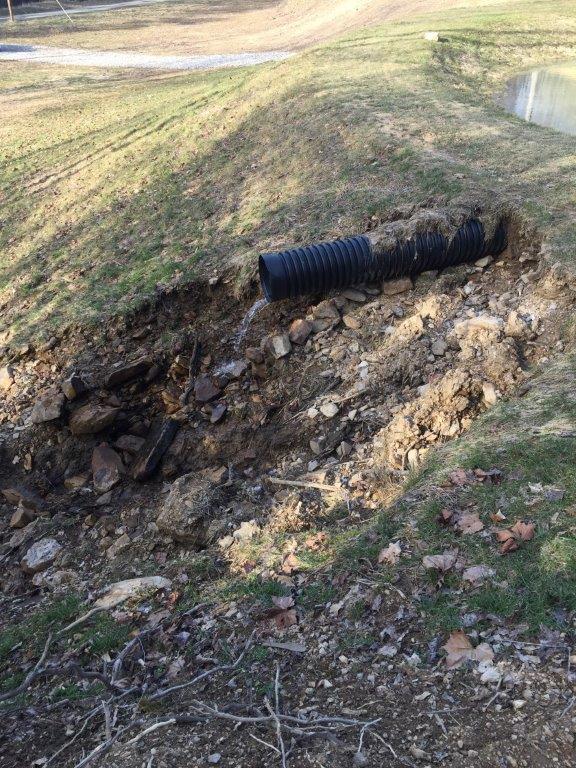
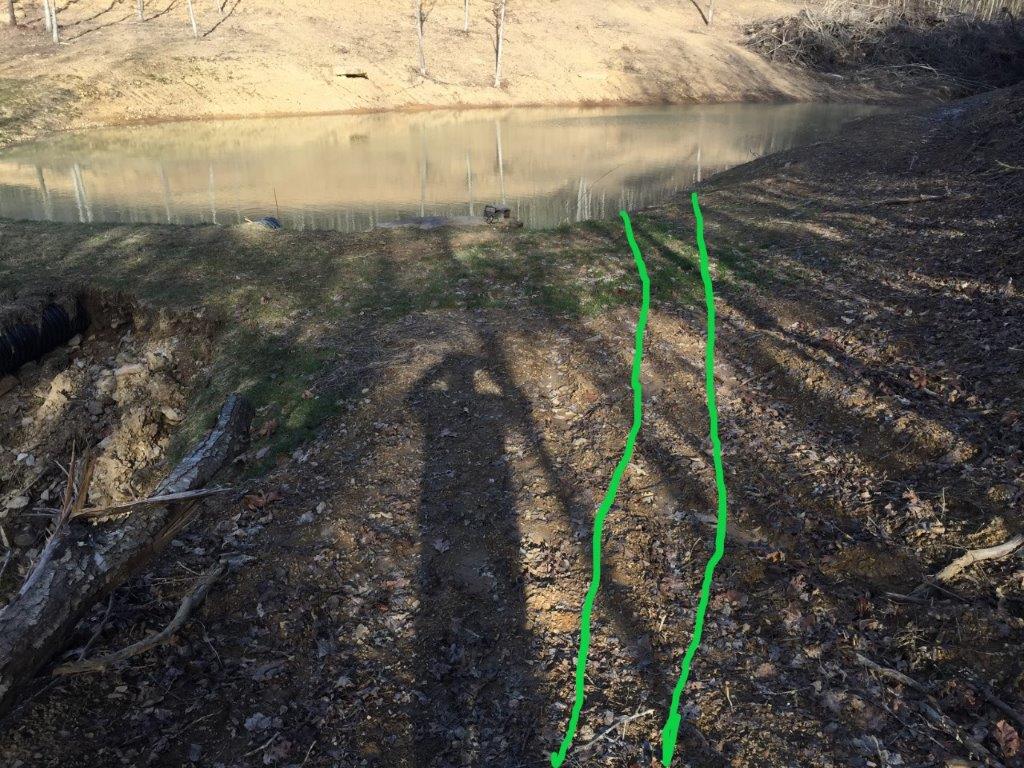

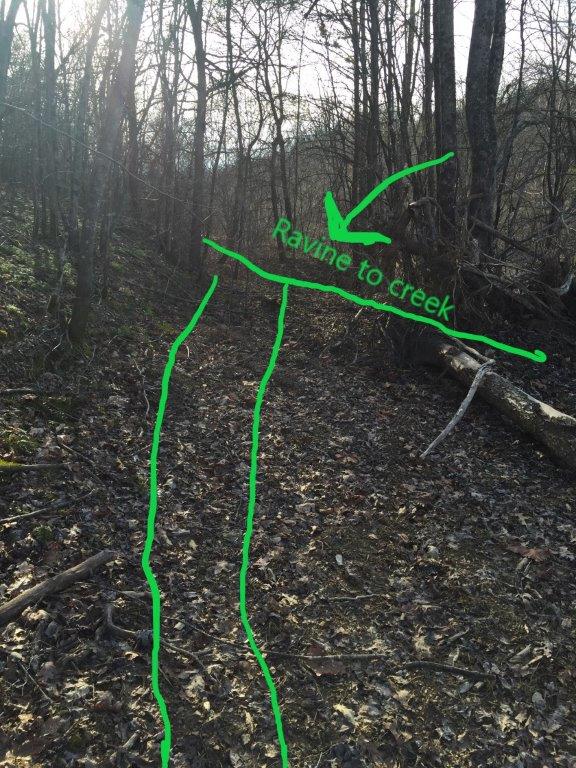

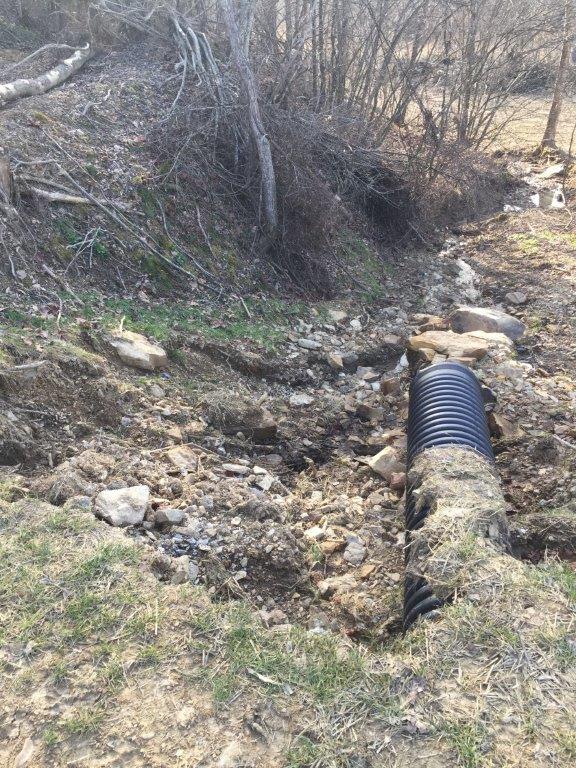
Also, I am well aware I have very little freeboard but I am also planning on using a lot of the dirt coming out of digging the emer overflow to build up the dam another foot or so if possible... I will probably need to did down around 2-1/2 - 3 ft for the emer spillway as it goes up at quite an angle heading toward the ravine. I know none of these may be the best solution but I am just trying to get somewhat of a solution in place until I can maybe do something more extensive. We had an unusually large amount of rain for our area the month of Feb, or normally it handles the watershed fine 90-95% of the time.... Plus during the time I will be working on this I am going to use my 300GPM semi-trash pump to pump the pond as dry as possible. I had it down about 3-4 ft last week and it took about 6 days to fill back up with no more rain.
It does look like you freeboard is small as is the dam width. One additional thing to consider is refitting you pipe with the exit end as low as possible and installing an anti-vortex plate to increase the amount of water flowing through your pipe during flooding. The pipe should be repacked well with high clay soil as should any dirt layered on top the dam. Best of luck.
It does look like you freeboard is small as is the dam width. One additional thing to consider is refitting you pipe with the exit end as low as possible and installing an anti-vortex plate to increase the amount of water flowing through your pipe during flooding. The pipe should be repacked well with high clay soil as should any dirt layered on top the dam. Best of luck.
Any ideas where you buy those? I looked just now and the only ones I could find were meant to go on riser style pipes and not horizontal style like mine....
All of the "dirt" around this is clay, so using clay should not be an issue.
Could you put in a diversion structure to move some of the water around the pond during extreme floods, so not as much water enters the pond? If so, that could save you losing fish, and also go a long way toward mitigating silting in of the pond.
I made my anti-vortex plates. A simple way to do this is to wrap a stiff sheet of flexible metal around the top of the entrance pipe and bolt in place like a hood sticking into the pond beyond the pipe. The plate keeps a whirl-pool from forming and sucking air into the pipe.
Some specs for the emergency spillway:
https://www.nrcs.usda.gov/Internet/FSE_DOCUMENTS/nrcs142p2_023318.pdfOn one of my ponds, I built a trash rack from pieces of hog panels and put a solid top on it made from a piece of roof metal. Anything that shields the top of the pipe to prevent air from being sucked in once the pipe is full should do the trick.
http://www.livingthecountrylife.com/homes-acreages/ponds/creating-and-fixing-pond-spillways/
As RAH's NRCS link above shows, the anti-vortex plate needs to be 1.5 times as wide as your pipe. I used a 12" wide plate of alumimum bolted over the 8" pipe with stainless all-thread:

Could you put in a diversion structure to move some of the water around the pond during extreme floods, so not as much water enters the pond? If so, that could save you losing fish, and also go a long way toward mitigating silting in of the pond.
John, I wish I could, but I have hills pretty much on both sides of the pond so it would take an enormous amount of dirt removal to be able to do that. But it is something I had thought about.
As RAH's NRCS link above shows, the anti-vortex plate needs to be 1.5 times as wide as your pipe. I used a 12" wide plate of alumimum bolted over the 8" pipe with stainless all-thread:

Ahh... pictures are worth a thousand words. Thanks!
How did you bend the threaded rod? Looks great BTW.
Since you stated on another site that you are going to drain the pond down, why don't you build a siphon system and let it do the work instead of a pump. Rick
How did you bend the threaded rod? Looks great BTW.
I had bought a 6' stick of 1/4" all-thread (ebay I think), cut it into two pieces. I slowly bent them around the pipe trying not to kink it. No problem. After tightening the nuts down I sawed off the excess thread. Don't saw them off before getting it through the holes you drilled in the plate!
I second the thought of using a temporary siphon system to draw down the pond. Search on YouTube for videos. I used 2" PVC, and only glued the angles and cleanout on top of the dam, the 10' sticks were connected by temporary fernco rubber couplings. You will need a screen on the intake. Much better to let it run 24/7 by itself and not worry about a gas engine.
As RAH's NRCS link above shows, the anti-vortex plate needs to be 1.5 times as wide as your pipe. I used a 12" wide plate of alumimum bolted over the 8" pipe with stainless all-thread:

Couple of questions on this.... did you jut heat and bend the all thread to fit the pipe? Also, can you use a bar guard with this in place, it looks like it would hinder putting one of those on the pipe?
Ok.... I decided to reach out to my local Soil, Water Conservation District folks for some more ideas.... I hope to have them come out in the next day or so as I will be using my 300GPM pump to hopefully pump the pond dry until I can come up with a solution.....
But, one of the things they mentioned after I spoke with them and sent them the pics is that I need approx. 25" of freeboard above the pipe, (which I knew I needed at least 18"), but when I asked about putting a bigger pipe in they said this one could possibly handle the watershed but b/c of the low freeboard there was not enough hydraulic head pressure to allow the pipe to run at full capacity... does this make sense. or sound right?
Also in building up the dam, I know it would be BEST to have a dozer or tractor with a sheepshead roller.. BUT, since I do not have either... Do you think I could add to the dam with just using my tractor and backhoe, and then using it's weight to compress the soil? It weighs between 5500 and 6000 lbs with the backhoe. The SWCD folks said you should only layer about 6" at a time on the dam and then compress it, which sounds right... just didn't know it others have built their dams just using the weight of the tractor to compress it. I am running R4 industrial tires on the tractor as well. Plus I am a little concerned at building it higher but not being able to make it much wider... of course if all here feel it would be better to just hire a dozer for a day to build up the dam and repair the it then that's what I will probably do... although I am still not sure if I do not want to put at least a 20" or 24" pipe in place of the current 18"... would hate to go to all that trouble of building up the dam to accommodate more freeboard and then find out that the 18" with a anti-vortex plate and more freeboard still is unable to handle the watershed.
I did not use heat to bend the 1/4" all thread, but it may have been better to use heat. You can surely design a bar guard that will fit over the plate - its needs to be a larger anyway - more "surface area" to collect trash.
It does make sense to have a higher free board to enable full flow of the pipe. Since you are only adding additional free board to the top of the dam that will not always have water against it, its my opinion your tractor can do sufficient compaction. Perhaps have the dozer out to push dirt while you run the tractor with all the weight you can get on it.
Have NRCS tell you what elevation the emergency spillway should be too. ie they set my water level (8' pipe) at 99' from a benchmark, the emergency spillway is two feet higher at 101', and the dam top at 103 which was expected to settle to perhaps 102. On second thought just have them design a pond as if yours was not there yet, then see what it takes to make yours "right".
Do you have a plan on getting extending the discharge pipe down the back of the dam?
I have used the back of the backhoe bucket to compact a couple of core trenched below grade after stripping the topsoil (in excellent clay soil). They have not leaked, but I did not take shortcuts on the tamping which takes a lot of time. I used a sheepsfoot above grade. Do you have the topography to install a drain in the bottom of the pond (I used a 3" schedule 40 PVC pipe for my last pond and put a valve at the bottom of the pond in case needed later). Having a drain let me get plenty of clay from the basin to over-build the dam. I tried to explain the advantages of a steeply sloped pipe above ("One additional thing to consider is refitting you pipe with the exit end as low as possible..."). This allows a pipe to carry as much water as a larger pipe set with little drop when full because the water in the pipe pulls more water in like a siphon when the drop increases. The anti-vortex plate keeps the pipe from pulling air which decreases the pipes capacity. Having a drain gives you time to work slower with existing equipment. A dozer is nice for moving soil out of the bowl if things are not too wet. You also get a deeper pond. If you zoom in on the far left in the pic below, you can see the hole I dug that has the drain pipe in the bottom.

I did not use heat to bend the 1/4" all thread, but it may have been better to use heat. You can surely design a bar guard that will fit over the plate - its needs to be a larger anyway - more "surface area" to collect trash.
It does make sense to have a higher free board to enable full flow of the pipe. Since you are only adding additional free board to the top of the dam that will not always have water against it, its my opinion your tractor can do sufficient compaction. Perhaps have the dozer out to push dirt while you run the tractor with all the weight you can get on it.
Have NRCS tell you what elevation the emergency spillway should be too. ie they set my water level (8' pipe) at 99' from a benchmark, the emergency spillway is two feet higher at 101', and the dam top at 103 which was expected to settle to perhaps 102. On second thought just have them design a pond as if yours was not there yet, then see what it takes to make yours "right".
Do you have a plan on getting extending the discharge pipe down the back of the dam?
Ok, sounds good... I make have to just fabricate something myself for the bar guard, or modify an existing one.
I will see if they will do that for me.
I am thinking about it, as they also mentioned that. I know they make the 22 degree angle pipe connector for the 18" pipe, not sure if they have them for larger than that.... I definitely like the idea of extending the pipe all the way down the dam, just was unsure if that would make the pipe not drain as freely, or just how I could get it to be supported correctly with the angle against the dam side.
Since you stated on another site that you are going to drain the pond down, why don't you build a siphon system and let it do the work instead of a pump. Rick
Does that need to go through the bottom of the dam? or are you talking about a system where you have to hook a vacuum pump to it to get it started and it is just PVC pipe running up the inside and outside walls of the dam?
How did you bend the threaded rod? Looks great BTW.
I had bought a 6' stick of 1/4" all-thread (ebay I think), cut it into two pieces. I slowly bent them around the pipe trying not to kink it. No problem. After tightening the nuts down I sawed off the excess thread. Don't saw them off before getting it through the holes you drilled in the plate!
I second the thought of using a temporary siphon system to draw down the pond. Search on YouTube for videos. I used 2" PVC, and only glued the angles and cleanout on top of the dam, the 10' sticks were connected by temporary fernco rubber couplings. You will need a screen on the intake. Much better to let it run 24/7 by itself and not worry about a gas engine.
Good to know...
Well I did use a siphon a couple of times using 100' of 4" corrugated drain pipe... what a PAIN in the rear to get pulling... plus once I had it pulling if you went too deep in the pond I found it could not make the pull up the inside wall of the dam, I guess it was too steep, or too big of a pipe. I liked the idea of maybe installing a permanent siphon system just do not know how. I will do some research on that as well since like you said, no fun to keep gassing up a pump every 1.5 hrs...
Neo07, you've gotten lots of good advice.
If you're worried about the immediate damage to the back of the dam, then I might look at geotextile road fabrics. I've been using it for several years now under limestone rocks on 24' watershed pipes, and a small emergency spillway. Erosion has pretty much stopped.
I did look into that but finding the stuff where I live has been tough...
I have used the back of the backhoe bucket to compact a couple of core trenched below grade after stripping the topsoil (in excellent clay soil). They have not leaked, but I did not take shortcuts on the tamping which takes a lot of time. I used a sheepsfoot above grade. Do you have the topography to install a drain in the bottom of the pond (I used a 3" schedule 40 PVC pipe for my last pond and put a valve at the bottom of the pond in case needed later). Having a drain let me get plenty of clay from the basin to over-build the dam. I tried to explain the advantages of a steeply sloped pipe above ("One additional thing to consider is refitting you pipe with the exit end as low as possible..."). This allows a pipe to carry as much water as a larger pipe set with little drop when full because the water in the pipe pulls more water in like a siphon when the drop increases. The anti-vortex plate keeps the pipe from pulling air which decreases the pipes capacity. Having a drain gives you time to work slower with existing equipment. A dozer is nice for moving soil out of the bowl if things are not too wet. You also get a deeper pond. If you zoom in on the far left in the pic below, you can see the hole I dug that has the drain pipe in the bottom.

Well. one of those things like I said before... If I knew then what little I know now I would have done several things different, a bottom drain or siphon system being a couple... and an emergency spillway. I'm just not sure how you would install a bottom drain where a dam has already been created without breaching the dam core and causing possible leaks later on.
The bottom drain in my first pond was put in after the dam was done. The trench was dug, and when burying the pipe, each scoop was packed with the back of the excavator bucket. I did install the bottom drain on the new pond before adding the top 6 feet. I needed it to take incoming water during construction.
The bottom drain in my first pond was put in after the dam was done. The trench was dug, and when burying the pipe, each scoop was packed with the back of the excavator bucket. I did install the bottom drain on the new pond before adding the top 6 feet. I needed it to take incoming water during construction.
Interesting....
Well here is the latest from the local SWCD folks:
I again talked with our engineer, and I also figured the acres of watershed for your pond. So with not being at your pond site before, the numbers are rough estimates. I came up with 32 acres of watershed for the pond. From that ran some numbers and the CFS (cubic feet per second) for the watershed for a 2 year storm would be 23 CFS, and for a 10 year storm around 47 CFS. So with that being said the 18Ē diameter pipe you currently have installed in your pond would carry the normal 2 year storm with anti-vortex hood. However you would have the need for an emergency spillway as we discussed earlier on the phone in the event of a larger storm. Also I would recommend extending the existing pipe further without any angles because the angle would cause a reduce of flow in the pipe. There would also be the need to increase the elevation of the dam to meet the required head pressure for the 18Ē pipe to flow full (which we talked about on the phone). See attached for hooded inlet drop structure form to better explain. Again the numbers are rough estimates. I will try to make it out to your pond site around 10:00 if that works for you.
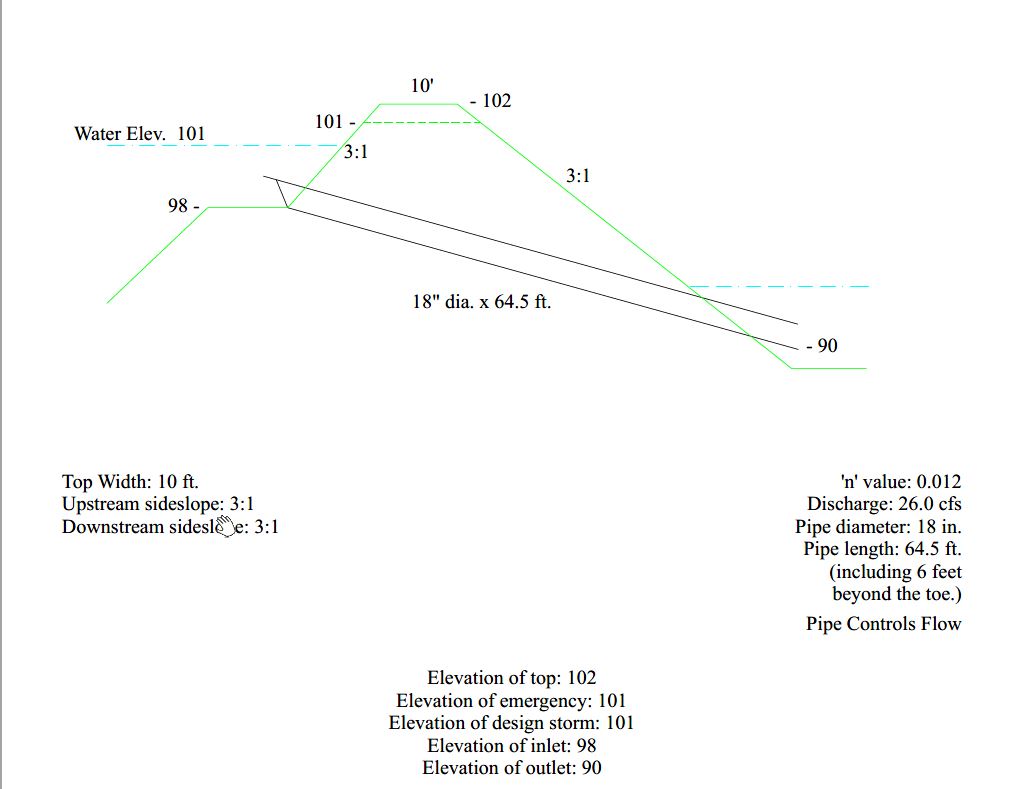
Well thats very helpful, and will be fine tuned once they visit to see the site. When they come out ask about the use of that double wall HPDE corrugated pipe. I'm skeptical it and its joints are rated for a siphon effect in a downslope dam installation.
Neo07, you've gotten lots of good advice.
If you're worried about the immediate damage to the back of the dam, then I might look at geotextile road fabrics. I've been using it for several years now under limestone rocks on 24' watershed pipes, and a small emergency spillway. Erosion has pretty much stopped.
I did look into that but finding the stuff where I live has been tough...
Amazon has it. I got the Mutual WF200 Tire Scrub Fabric. It was less than $80, and has held up very well.
Well thats very helpful, and will be fine tuned once they visit to see the site. When they come out ask about the use of that double wall HPDE corrugated pipe. I'm skeptical it and its joints are rated for a siphon effect in a downslope dam installation.
Ok, will do. Thanks!
Looks like topsoil on the dam around the spillway, I like to pack clay around and on top to make sure it doesnít wash next to pipe and bypass it....on the downside of the dam you might have to extend the rock and concrete so it donít wash so bad
Looks like topsoil on the dam around the spillway, I like to pack clay around and on top to make sure it doesnít wash next to pipe and bypass it....on the downside of the dam you might have to extend the rock and concrete so it donít wash so bad
Yes, about the last 2" I had them put topsoil to help expedite the growth of grass/foliage on the top and sides of the dam, the rest is good clay.
Correct... that's what I said above, I am planning on adding both to the sides and bottom with more rock and concrete, although the bottom is only about 2' from the creek bed now. It is just difficult to see from that pic.
How much was the cost of this pond?
Was skimming and saw this - on one of my ponds we had the short overflow as well, I used the tailrace method with a corrugated pipe cut lengthwise and anchored with 4' x 3/8" rebar. Vertical drop is about 21'.
![[Linked Image]](https://forums.pondboss.com/gallery/49/full/17930.jpg)
![[Linked Image]](https://forums.pondboss.com/gallery/49/full/17931.jpg)
This has been flowing water with zero erosion for 6 years with no maintenance.

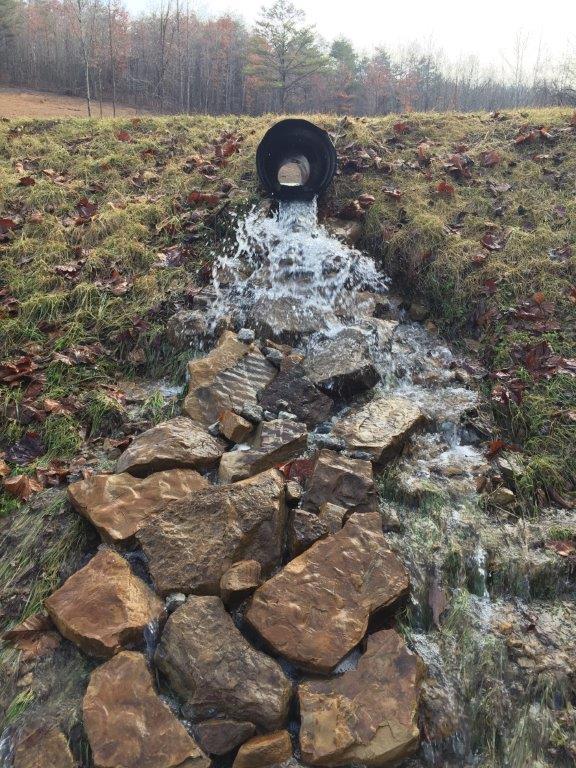
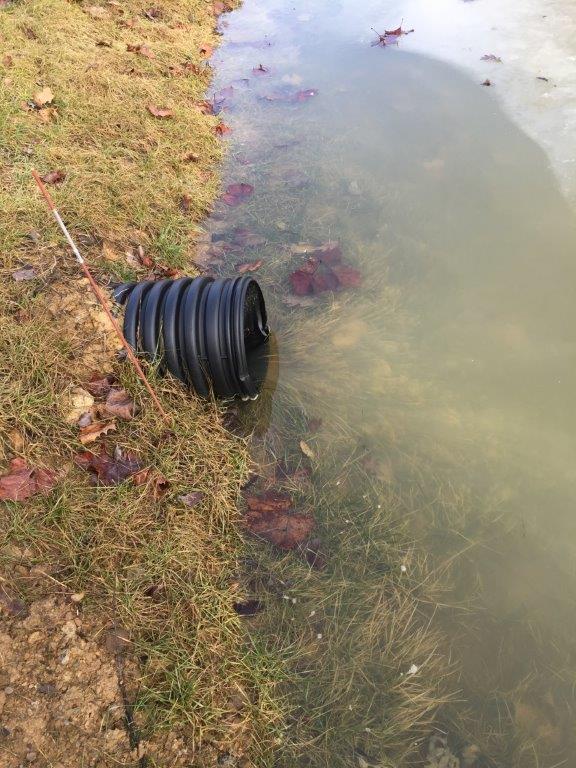
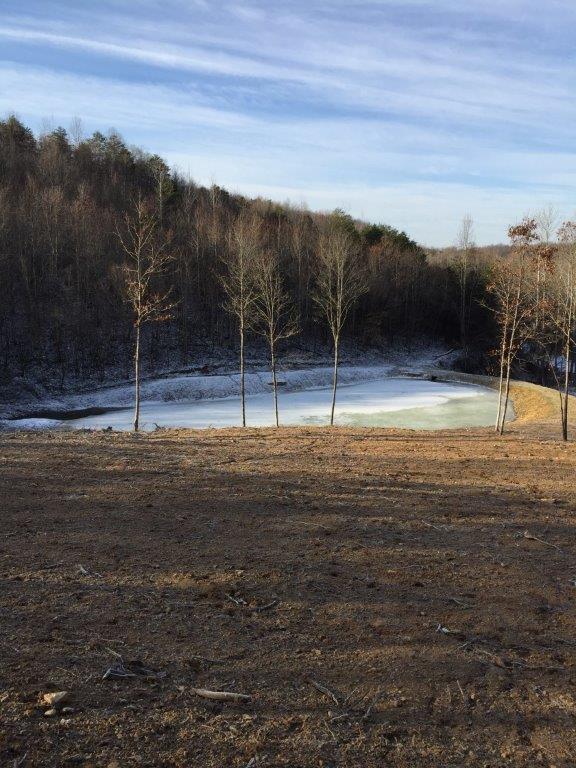





















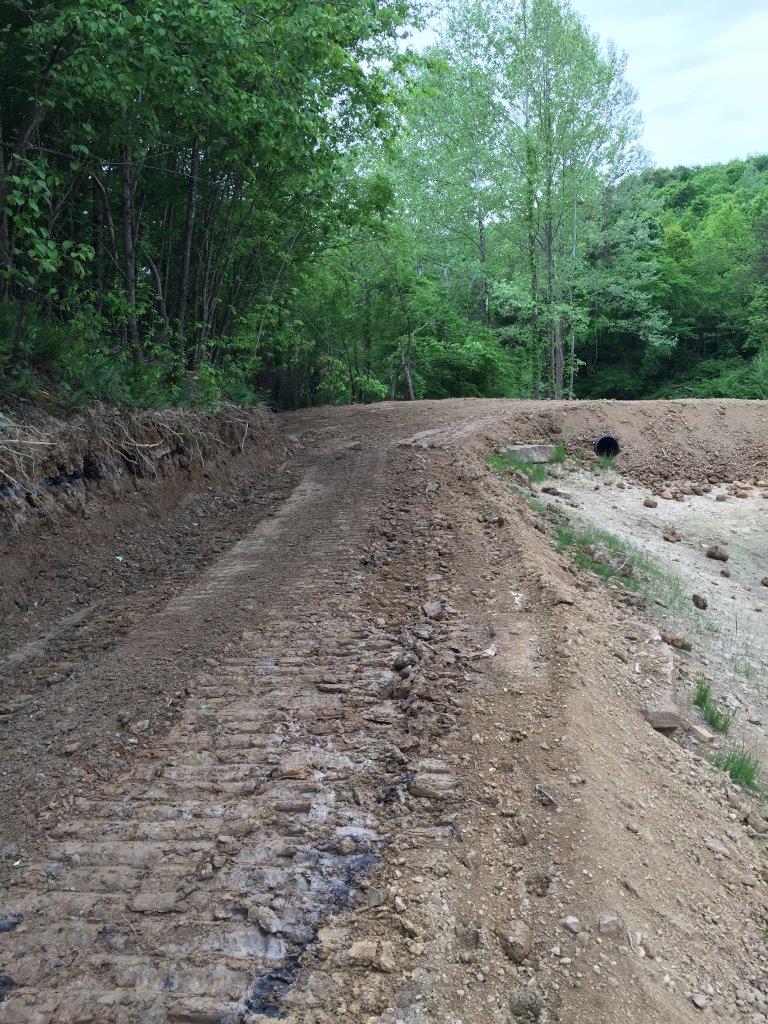

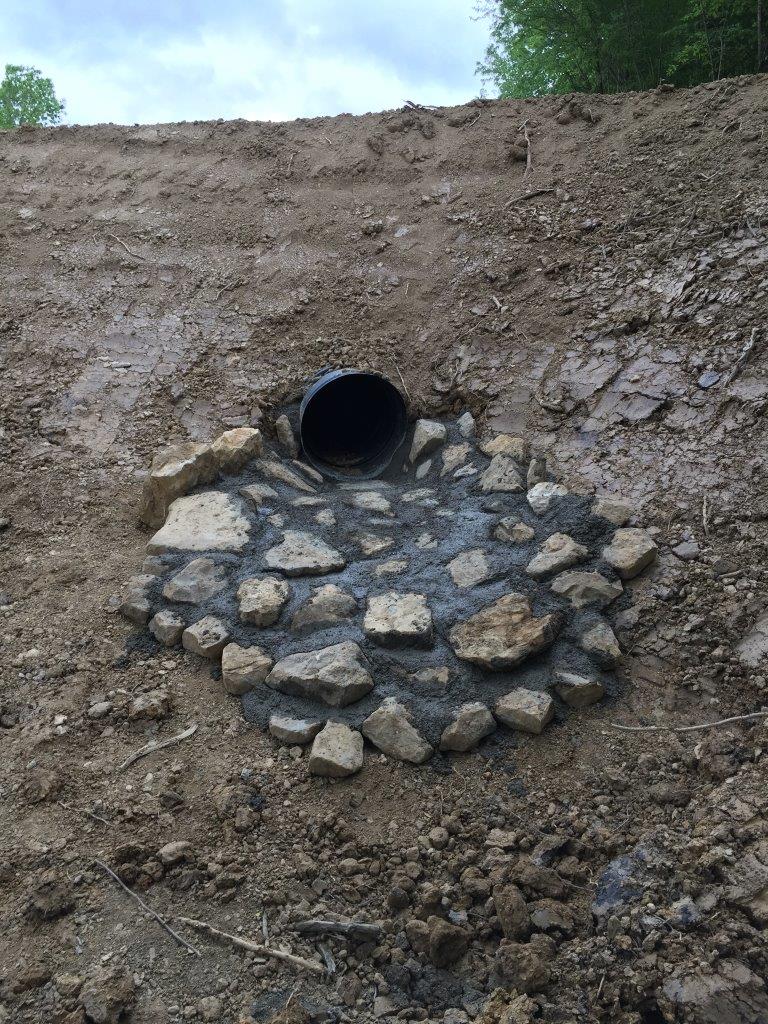
![[Linked Image]](https://forums.pondboss.com/gallery/49/full/17930.jpg)
![[Linked Image]](https://forums.pondboss.com/gallery/49/full/17931.jpg)